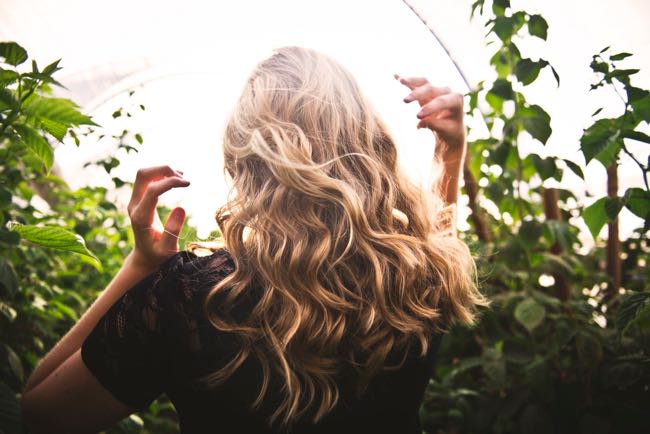
Have you tried hair-moisturizing treatments? Have you used hot oils, wraps, and other methods to try to get that soft, luxurious look you’re going for? Did they work?
Pampering the hair itself can often help it to look better, but if you really want healthy-looking hair, you have to start at the beginning: with the scalp.
Why a Healthy Scalp Matters to Healthy-Looking Hair
The scalp is like the soil for your hair—it provides the foundation, while nourishing each of the follicles as they grow. If your scalp isn’t healthy, your hair won’t be, either, no matter how you may treat it.
What we often forget is that the scalp is covered by skin, and the condition of that skin is just as important as the condition of the skin on the rest of the body. The scalp produces sebum (skin oil) just like your face does, only instead of producing it through the pores, it produces it through the hair follicles. Having healthy, moisturized skin on the scalp is key to having shiny, lustrous hair, because the hair emerges from this skin.
If the follicles are clean, clear, and healthy, hair will grow as it should and will look its best. If the follicles are full of sebum, blocked by dead skin, or otherwise damaged by dandruff or an infection, hair will struggle to grow as it’s supposed to.
If you’re wondering just how healthy your scalp is, ask yourself these questions:
- Does my scalp itch? Am I often scratching my head?
- Do I feel any burning sensations on my scalp?
- Is my scalp really oily?
- Do I have dandruff?
- Does my hair look dry and dull?
If you answered “yes” to any of these questions, your scalp may be struggling.
7 Ways to Create a Healthy, Happy Scalp
Fortunately, with a little care, you can have a scalp that is healthy and better able to produce the type of hair you want. Try these five tips:
1. To Avoid Dry Scalp, Avoid Harsh Hair Products
Just like you want to use gentle, natural products on your skin, you want to do the same thing for your hair. Harsh sulfates, fragrances, and alcohols can dry the hair, which in turn, leads to a dryer scalp. Hair dyes, as well, are drying, particularly if they contain bleach. Choose sulfate- and fragrance-free hair products, and try to limit how many times you get your hair colored each year.
2. Exfoliate Your Scalp
You regularly exfoliate your skin, but what about your scalp? The skin there can also suffer because of dead-cell buildup. If you clear this buildup away, it will clear your follicles and create healthier-looking hair. Exfoliating can also help if you have excess oil on your scalp. This oil can mix with dead skin to clog hair follicles and lead to hair loss or thinning. Look for products that talk about “reviving the scalp,” “exfoliating,” or “treatment” and then use them at least once a week, more often if needed.
3. To Avoid Itchy Scalp, Moisturize Your Scalp
If you have dry hair, it may be that a dry scalp is to blame. A dry scalp can also feel itchy. Try stepping up your moisturizing activities. Treat the scalp with beneficial oils like jojoba and olive. Simply massage into the scalp, allow to sit for 20 minutes or so, then rinse out. You can also leave it on overnight.
Consuming more omega-3 fatty acids can help moisturize your hair from the inside out. Eat more salmon, walnuts, and flaxseed, or try a fish oil supplement.
4. Cleanse Regularly
It can be hard sometimes to determine how often to wash your hair. Wash it too often, and you risk drying the scalp. But if you don’t wash it often enough, you may suffer from dirt and oil buildup, and itching. Common advice is to wash it every other day, and if you’re extra oily, use a clarifying shampoo once every couple weeks. You can also use apple cider vinegar as a clarifying rinse.
5. Massage Your Head
This not only feels good, it helps promote blood flow to the scalp, which helps promote healthy hair growth. Once a week, simply massage the scalp with your fingertips using a firm, circular motion. You can also regularly massage the scalp when washing your hair.
6. Treat Dandruff
If you have dandruff, treat it right away—don’t let it continue as it can weaken the hair follicle and lead to hair loss. Talk to your doctor about treatments, or use over-the-counter dandruff products. You can also make your own by adding some tea tree oil or apple cider vinegar to your shampoo.
7. Give Your Hair a Break
Hair dryers, curling and straightening irons, tight styles, and more can all damage the hair and dry out the scalp. Try designating at least one day a week as a “style free” day to give your hair and scalp a break.
Extra Tips for Hair Loss and Baldness
If you’ve gone through cancer treatments, you know they can negatively affect your scalp, causing hair loss, redness, and rashes. Here are some tips for you:
- Use our Rescue + Relief Spray for immediate, cooling relief. Apply as needed. Over time, this product will help promote healing.
- If your scalp itches, combine mashed oatmeal and yogurt and apply to the hair and scalp. Leave on for 15 minutes then rinse off.
- Moisturize your scalp with our Calming Moisture for Face, Neck, and Scalp. You can also leave it on for 10-15 minutes as a moisturizing mask.
- Apply tea-tree oil directly to any infected area.
- Wigs can trap heat and oils on the skin. If you’re wearing them, try to give your head a break a couple days a week.
How do you maintain a healthy scalp?

